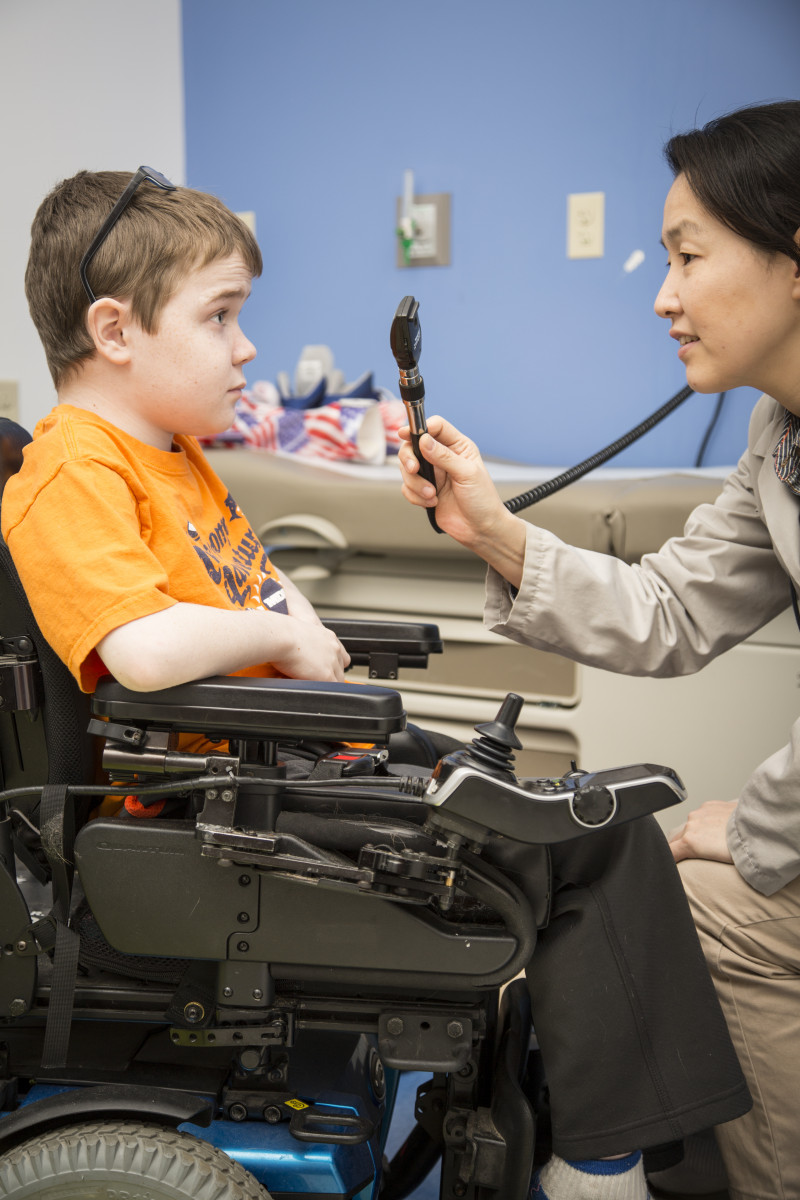Gene Therapies, Redosing, and Other Work Underway in Treating Pompe: Talk With MDA

A child being examined at an MDA care center. (Photo courtesy of the MDA)
Gene therapies — after a tragedy kicked them back to the lab two decades ago — are beginning to come into their own, making possible the progress in gene-targeted and combination treatments for neuromuscular diseases once thought unimaginable.
But many challenges remain — from the likelihood of no “one and done” gene therapy existing for diseases such as Pompe, Friedreich’s ataxia, and muscular dystrophy, to the sheer amount of vector needed for both system-wide and central nervous system treatment — especially for rare neuromuscular disorders, said Sharon Hesterlee, PhD, an executive vice president and chief research officer for the Muscular Dystrophy Association.
Jesse Gelsinger’s death in a gene therapy trial in September 1999 “really set the whole field back for a long time,” Hesterlee said in a wide-ranging phone interview with BioNews Services, the parent company of this website.
But the MDA “continued to invest … through that whole dry period, with the thought that this is going to work. We just have to figure out how.”
Hesterlee has a more than 20-year career in the pharmaceutical and biotech industries as well as nonprofits (including with the MDA, where she worked in drug translation and venture philanthropy from 1998 to 2009).
She welcomes gene therapy’s return, and some sense of accomplishment for the more than $1 billion the group has invested in neuromuscular disease research since its 1950 founding.
“Now we’re seeing the maturation of that [gene] technology, a much better understanding of the issues, and we’re starting to see successes,” she said.
She, like others, points to the U.S. approval of the first gene therapy in a neuromuscular disease — Zolgensma, by Novartis, for spinal muscular atrophy (SMA) — as an initial breakthrough and a sign of what might yet come.
Translating that success to other patients, however, will take time.
Two big challenges, but glimmers of hope
Two broad challenges exist for gene therapies in neuromuscular ills, especially rare ones, Hesterlee said, with numerous mini-hurdles within those categories.
One is getting the therapy to all affected muscles and organs and, along with that, being able to produce the huge amounts of viral vector required to transport it.
As one recent study of work into a Pompe gene therapy, by scientists that include Barry Byrne, MD, PhD, and Manuela Corti, PhD, at the University of Florida (UF), noted: the vector amounts necessary exceed current production techniques on a scale that would not be suitable to support either Phase 3 clinical trials or regulatory approval requests.
The other is the real likelihood that such treatments would have to be given again over a person’s lifetime, which means getting around resistance raised by the immune system. An immune response to a gene therapy now comes in the form of antibodies against whatever virus carries the “healthy gene” to cells as a transport vector, even when that virus is re-engineered to be harmless.
“I think we know we’re going to have to treat people again, and right now what we’ve done is immunize them against the vector,” Hesterlee said. “They’re developing really high antibodies after treatment, so you can’t use the same vector.”
The challenge of knowing whether Zolgensma is truly a one-time SMA treatment remains. A gene therapy is likely to be much more stable in the central nervous system (CNS, comprising the brain and spinal cord) than in muscle, Hesterlee said, but only time will definitively tell.
“People speculate ‘one and done‘ [but] we know that might not be the case,” she said. “We just don’t have enough long-term data to really understand how long this lasts in muscle, how long this lasts in the CNS.”
Scientists are meeting these challenges head-on. Hesterlee mentioned a Phase 1 trial (NCT02240407) underway by Byrne and others at UF that is redosing people with late-onset Pompe disease, using a immuno-suppression regimen described in a recent study.
Cooperation across private interests and nonprofit patient groups such as the MDA is coming to the fore. Examples include a first multi-drug, or platform, clinical trial for a neuromuscular disease such as amyotrophic lateral sclerosis — the Healey ALS Platform Trial — and growth in collecting and sharing comprehensive patient data, like the MOVR registry that the MDA is establishing.
“It really does make sense that you want to bring as many resources together as possible in rare disease spaces. You can’t duplicate resources,” Hesterlee said.
Meanwhile, less rivalry is evident across companies, institutions, and associations, and that’s a huge leap, she said.
“People are starting to share the datasets they used to horde. I think all of this … bodes well for the future.”
Upcoming therapies for Pompe
Pompe disease, or glycogen storage disease type II, is caused by mutations or other problems in the GAA gene that prevent a large and complex sugar molecule stored in muscle cells (glycogen) from breaking into glucose as it should. The result is widespread weakness in both skeletal muscles and those of the heart and respiratory system.
Enzyme replacement therapy (ERT) is the mainstay of Pompe treatment to date, with one such therapy approved — called Lumizyme (alglucosidase alfa) in the U.S. and Myozyme in Europe, both marketed by Sanofi Genzyme.
But most everyone, including Genzyme, recognizes that “there’s room for improvement,” Hesterlee said. It’s one focus of the MDA’s funding.
The nonprofit gave out $16.8 million in direct research grants in 2019 (part of a total $66 million multi-year funding commitment), and anticipates awarding about $18 million in 2020, she said.
Work underway in next-generation ERTs includes:
- chaperone therapies to overcome the limitations of ERT, such as AT-GAA by Amicus Therapeutics, now in the fully enrolled Phase 3 PROPEL trial (NCT03729362) in adults with late-onset Pompe
- avalglucosidase alfa, a next-generation ERT by Genzyme that is finishing a Phase 2 trial (NCT03019406) in infantile-onset Pompe, and a Phase 3 (NCT02782741) in those with late-onset disease. People enrolled in these studies are entering a Phase 2/3 extension study (NCT02032524), called NEO-EXT, that runs through December 2021.
Gene therapies are also being studied in people with this disease, as current treatments cannot cross the brain-blood barrier (a protective membrane meant to block blood-borne threats) and so “do not effectively target GAA deficiency and glycogen accumulation in the nervous system,” Byrne at UF, and others, said in a recent Pompe study.
Audentes Therapeutics is working to open a Phase 1/2 clinical trial (NCT04174105) of its potential gene therapy, AT845, in up to eight adults with late-onset disease. Hesterlee expects this trial to get underway, likely in 2021.
One trial that’s “kind of flying under the radar,” Hesterlee said, is underway from Actus Therapeutics (a spin-off of AskBio). This Phase 1/2 open-label trial (NCT03533673) is testing the company’s gene therapy AAV2/8-LSPhGAA (also known as ACTUS-101) in up to six adult patients. This study may still be enrolling at its one North Carolina (Duke University) site; contact information is available here.
Challenges being met
Important work is also being led by Byrne and Corti at UF into the possibility of re-treating Pompe patients with a gene therapy. The Phase 1 study (NCT02240407), done in partnership with Lacerta Therapeutics (which Byrne co-founded), is testing the use — and reuse (once in each leg, four months apart) — of an AAV-delivered gene therapy (rAAV9-DES-hGAA) in up to seven adults with late-onset disease.
“Immuno-suppression work [here] is clear,” Hesterlee said, particularly in B-cell depletion.
The depletion, or ablation, of these key immune cells is being done through use of Rituxan (rituximab), more commonly used to prevent the spread of certain lymphomas, and sirolimus (brand name Rapamycin or Rapamune), a common pre-transplant immune suppressor, prior to the therapy.
“He’s been able to do this successfully,” Hesterlee said of Byrne’s work, mentioning a 2019 presentation (abstract 290, page 140) he gave at the American Society for Gene & Cell Therapy. His talk covered a similar combination that prevented an antibody reaction in serum samples from people with Friedreich’s ataxia. Years earlier, Byrne presented immuno-suppressive work and re-treatment on a person with Canavan disease.
Many gene therapies for diseases involving skeletal and other muscles will likely never be “one and done,” Hesterlee said. That’s because the viral vector used, some form of an AAV, goes into mature muscle cells rather than dividing cells.
“And if you add muscle mass,” as you age and grow, “you’re not making more copies of that gene that you brought in,” she said. “It sits outside the chromosome, so it will eventually get diluted. … I think we know we’re going to have to treat people again.”
Researchers, in other words, know that people with diseases such as Pompe — and many of the 39 other neuromuscular disorders that the MDA represents and supports — will need to be treated with a gene therapy more than once. The question is how.
“I think that’s going to be a big, big challenge,” Hesterlee said. “How do we deal with people that have pre-existing antibodies, and then how do we deal with redosing?”







